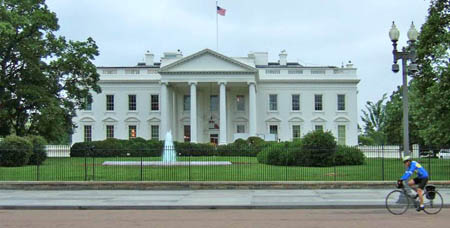Letter from America
Ex-pat Polly Low reports from Washington DC.

America’s love affair with the car is the stuff of legend. So it’s both a surprise and something of an embarrassment for a Mancunian to arrive in the capital city of this gas-guzzling, SUV-worshipping country, and find that the lot of the cyclist here is, in many ways, far happier than it is back home.
The topography of the city perhaps gives it a head start. A grid system of (mostly) wide streets, interlaced with regular intersections, keeps most traffic fairly slow, while allowing cyclists plenty of space – often a whole lane – to claim as their own. But deliberate efforts have also been made to make the streets more cyclist-friendly. Signs reminding all users to ‘share the road’ make a nice change from cyclists being labelled a hazard. Dedicated on-street cycle paths are relatively rare, but, when they do appear, tend to be of respectable length and width. It’s also legal for cyclists to ride on pavements outside the city centre.
For a more bucolic experience, off-road (but fully surfaced) cycle paths stretch out of the city in all directions (the Greater Washington area claims to have 670 miles of surfaced, off-road bike trails). Particularly popular is the twelve-mile Capital Crescent Trail. On weekdays, the trail forms a convenient commuter route from the northern suburbs to the heart of the city. At weekends, it’s a magnet for cyclists, joggers and walkers of all ages. And when weekend riders reach the northern end of the route they can complete a loop back home by heading down Beach Road: one of the main roads into the city, and entirely closed to motor traffic at weekends.
Integration with public transport is – from a Mancunian perspective – enviable. Bicycles are allowed on all underground lines (four per carriage; trains usually have six carriages), although only at off-peak times. Even better, every bus in the city is equipped with a bike rack, which carries two bikes, at no extra cost, and with no restrictions on time or route.
Washington is not a cycling utopia. But it has become a much better place for biking in the past decade or so, and its experience should perhaps be all the more important for that. The Washington example shows how, even in a crowded, car-loving city, a combination of local pressure (an energetic cycling campaign, numerous local activists, and a clutch of dedicated advocacy groups for the off-road trails) and political will can bring about real change in cycling infrastructure and culture. Washington’s newly-elected mayor – a keen cyclist, who appeared at bike-to-work day in some very spiffy lycra – has promised that even more improvements are the way: more bike lanes, a new bike trail, and 300 bike parking spaces at the new baseball stadium (with – this being America – valet parking for all cyclists). Perhaps Manchester’s politicians might take note?

